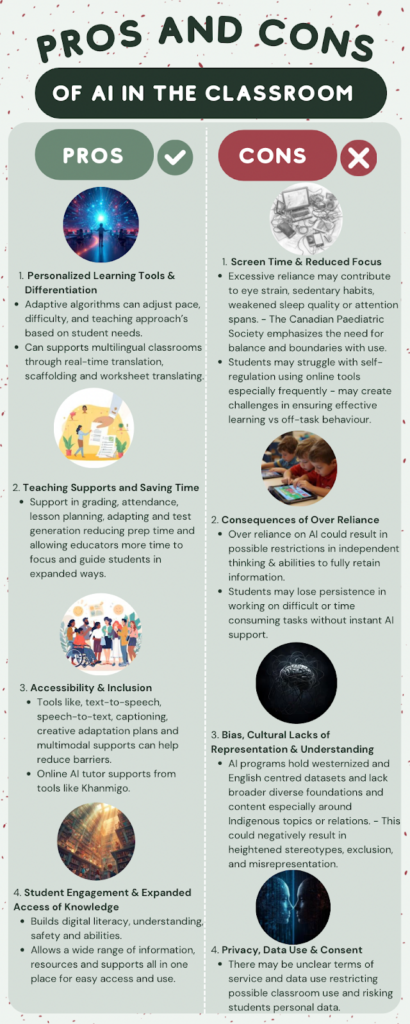Podcast Summary:
This week I decided to try a different approach to sharing my learning and research by putting it into a more podcast-style audio reflection and breakdown. My main guiding question this week was, Is the active use of technology and AI healthy for students everyday learning? I talked about personal classroom experiences and policies around technology in this generation. I highlighted a wide range of considerations to take when integrating a healthy use of AI/technology into a school environment including, distraction, overreliance, gaps of cultural knowledge, possible negative modeling online impacting students behaviour, ethical privacy awareness and dynamic development of programs, along with access and available opportunity to use and understand AI programs. I also collaborated with educators to share their thoughts, opinions and experiences with AI in education and was surprised to find that many hadn’t yet looked into or explored AI outside of the general ChatGPT program. Then I researched further into the possibilities of AI use in education and downfalls which I will develop further into a visual representation provided below. In this, I also integrate AI use by trying out Canva’s AI tools, specifically the AI image generation based on the prompts I was focusing on. Finally, in the podcast segment I mention this week’s research emphasising AI being a support to humans rather than taking over completely due to many of the cons at the moment including, functions unable to fully wipe past version problems, and the lacking cultural knowledge and perspective gaps within these programs. Those I interviewed seemed to have a very similar view on AI integration in the classroom. We need comprehensive, “explainable AI” and expanded “interdisciplinary collaboration” to progress towards more advanced programs that contribute to a trustworthy and meaningful AI integration into education.
“But of course, there’s a downside. Next-generation language models will inherit most of this generation’s problems, such as an inability to tell fact from fiction, and a penchant for prejudice. Better language models will make it harder than ever to trust different types of media. And because nobody has fully figured out how to train models on data scraped from the internet without absorbing the worst of what the internet contains, they will still be filled with filth.” – Will Douglas Heaven in article, What’s next for AI by, MIT Technology Review
Supporting Resources Informing Reflection This Week:
- Canadian Paediatric Society. (2019). Digital media: Promoting healthy screen use in school-aged children and adolescents.
https://cps.ca/en/documents/position/digital-media - University Canada West. (2024). Advantages and Disadvantages of AI in Education.
https://www.ucanwest.ca/blog/advantages-and-disadvantages-of-ai-in-education - U.S. Department of Education, Office of Educational Technology. (2023). Artificial Intelligence and the Future of Teaching and Learning: Insights and Recommendations.
https://www2.ed.gov/documents/ai-report/ai-report.pdf - University of Illinois Urbana-Champaign, College of Education. (2024, October 24). AI in Schools: Pros and Cons.
https://education.illinois.edu/about/news-events/news/article/2024/10/24/ai-in-schools–pros-and-cons - Heaven, W. D. (2023). What’s next for AI. MIT Technology Review.
https://www.technologyreview.com/2023/01/09/1066707/whats-next-for-ai/ - Interaction Design Foundation. (2024). What is Human-Centered AI (HCAI)?
https://www.interaction-design.org/literature/topics/human-centered-ai - Alpha School. (n.d.). AI-first education model.
https://alphaschool.ca/
My Podcast Reflection:
Peer Educators Interviews:



